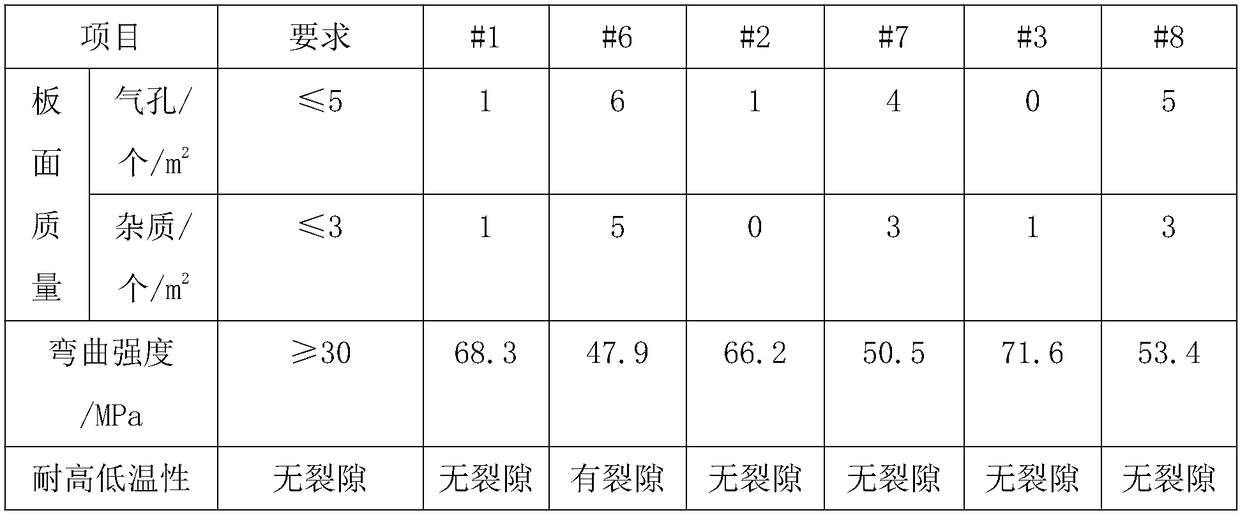Temperature-resistant and corrosion-resistant building glass ceramic
A glass-ceramic and corrosion-resistant technology, applied in the field of temperature-resistant and corrosion-resistant architectural glass-ceramics, can solve the problems of poor fire resistance and limited applicability, and achieve the effects of long service life, wide range and excellent temperature resistance.
- Summary
- Abstract
- Description
- Claims
- Application Information
AI Technical Summary
Problems solved by technology
Method used
Image
Examples
Embodiment 1
[0067] This embodiment relates to a heat-resistant and corrosion-resistant architectural glass-ceramic and its preparation process. The glass-ceramic is composed of the following raw materials in parts by weight:
[0068] 68 parts of siliceous shale;
[0069] 37 pieces of Yuliang stone;
[0070] 24 parts of vanadium-lead flotation tailings;
[0071] 27 parts limestone;
[0072] 18 parts of witherite;
[0073] 15 parts broken glass;
[0074] Na 2 CO 3 10 parts of powder;
[0075] Yb 2 o 3 6 parts of powder;
[0076] 3 parts of compound clarifying agent;
[0077] The above-mentioned composite clarifying agent is obtained by combining sodium nitrate, calcium sulfate, strontium chloride, and antimony-doped tin dioxide according to the mass ratio of 3:4:1:2.
[0078] The preparation process of this kind of glass-ceramic is generally carried out according to the following steps:
[0079] (1) Prepare raw materials: obtain raw materials according to the proportioning by we...
Embodiment 2
[0087] This embodiment relates to a heat-resistant and corrosion-resistant architectural glass-ceramic and its preparation process. The glass-ceramic is composed of the following raw materials in parts by weight:
[0088] 72 parts of siliceous shale;
[0089] 40 parts of Yuliang stone;
[0090] 28 parts of vanadium-lead flotation tailings;
[0091] 29 parts limestone;
[0092] 20 parts of witherite;
[0093] 18 parts broken glass;
[0094] Na 2 CO 3 12 parts of powder;
[0095] Yb 2 o 3 7 parts of powder;
[0096] 4 parts of compound clarifying agent;
[0097] The above composite clarifier is obtained by combining sodium nitrate, calcium sulfate, strontium chloride and antimony-doped tin dioxide according to the mass ratio of 3.5:4.5:1.5:2.5.
[0098] The preparation process of this kind of glass-ceramic is generally carried out according to the following steps:
[0099] (1) Prepare raw materials: obtain raw materials according to the proportioning by weight, and p...
Embodiment 3
[0107] This embodiment relates to a heat-resistant and corrosion-resistant architectural glass-ceramic and its preparation process. The glass-ceramic is composed of the following raw materials in parts by weight:
[0108] 75 parts of siliceous shale;
[0109] 43 pieces of Yuliang stone;
[0110] 30 parts of vanadium-lead flotation tailings;
[0111] 31 parts of limestone;
[0112] 22 parts of witherite;
[0113] 20 parts broken glass;
[0114] Na 2 CO 3 13 parts of powder;
[0115] Yb 2 o 3 8 parts of powder;
[0116] 5 parts of compound clarifying agent;
[0117] The above-mentioned composite clarifying agent is obtained by combining sodium nitrate, calcium sulfate, strontium chloride, and antimony-doped tin dioxide according to the mass ratio of 4:5:2:3.
[0118] The preparation process of this kind of glass-ceramic is generally carried out according to the following steps:
[0119] (1) Prepare raw materials: obtain raw materials according to the proportioning by...
PUM
| Property | Measurement | Unit |
|---|---|---|
| particle size | aaaaa | aaaaa |
Abstract
Description
Claims
Application Information
 Login to View More
Login to View More - R&D
- Intellectual Property
- Life Sciences
- Materials
- Tech Scout
- Unparalleled Data Quality
- Higher Quality Content
- 60% Fewer Hallucinations
Browse by: Latest US Patents, China's latest patents, Technical Efficacy Thesaurus, Application Domain, Technology Topic, Popular Technical Reports.
© 2025 PatSnap. All rights reserved.Legal|Privacy policy|Modern Slavery Act Transparency Statement|Sitemap|About US| Contact US: help@patsnap.com



